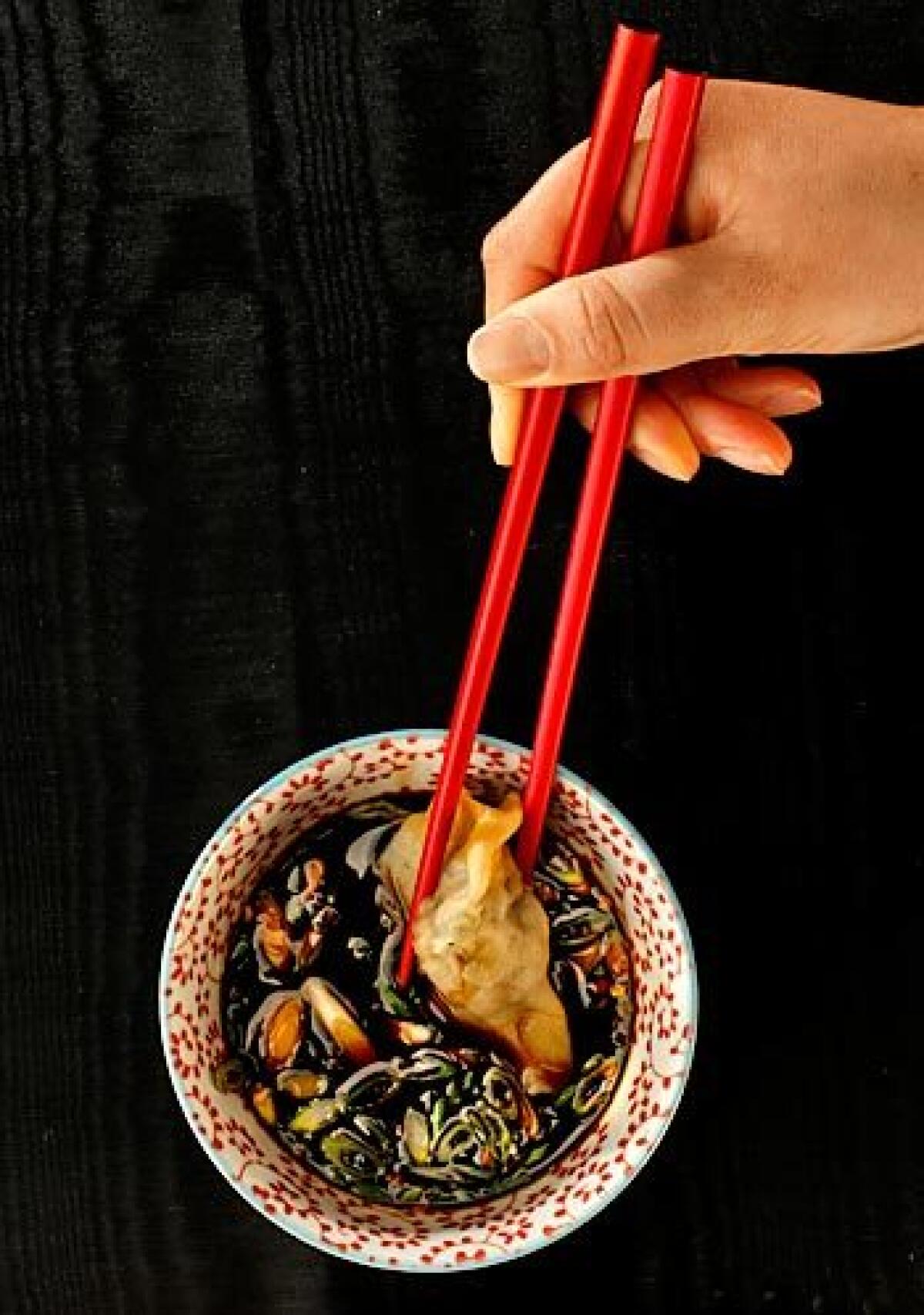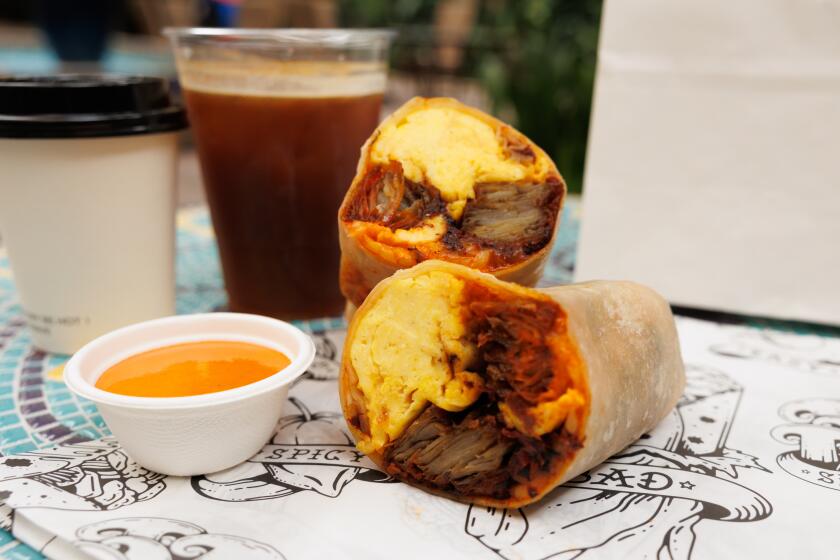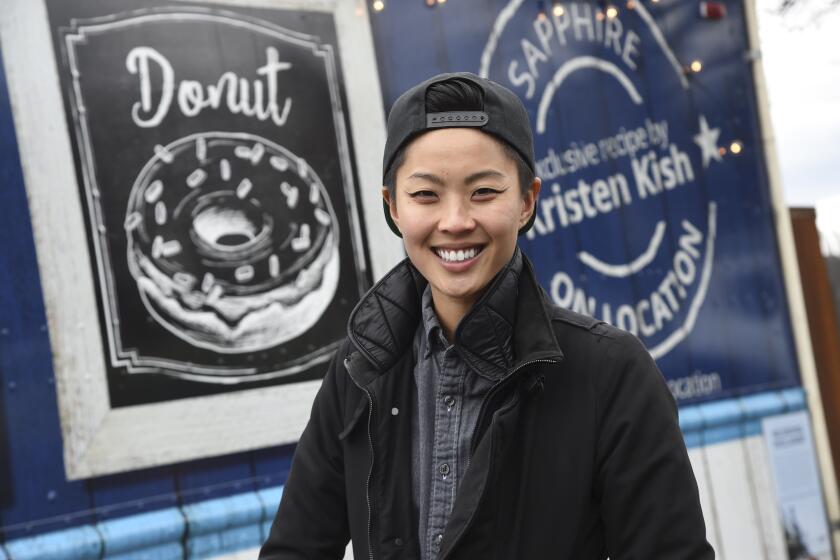Bundles of joy: Beijing-style dumplings for Chinese New Year

- Share via
Reporting from Beijing — On Saturday, amid the cacophony of firecrackers and other pyro-noise, most of China will be up all night to welcome in the Year of the Tiger. Here in the north, that will mean televisions blaring, watermelon seeds cracking, mah-jongg tiles clacking and, most important, people wrapping and eating dumplings. Northern Chinese eat dumplings on New Year’s the way Americans eat turkey on Thanksgiving (southerners have a whole different set of New Year eating traditions, relying more on sticky rice things).
Dumplings resemble the ingots that once were China’s currency, so eating them brings hope of an auspicious and fortunate year. Some cooks even stuff a lump of sugar in a dumpling to ensure sweetness, and sometimes, a coin is hidden inside. If you don’t break a tooth, you’re considered lucky for the year.
Dumplings seem to have been around forever -- visitors can see fossilized dumplings found in an ancient tomb at the Turpan Museum in Xinjiang province. However, their origins remain shrouded in folk tales. During the Han dynasty, it is said that Zhang Zhongjing, one of China’s most revered doctors, treated patients with frostbitten ears with a tonic of medicinal herbs and lamb wrapped in dough. He also fed his patients a soup containing two dumplings that were said to resemble a pair of ears. If you’ve ever seen a boiled dumpling with all its funny folds and wrinkles, just add some imagination, and the story takes on multiple meanings, like so many things Chinese.
Though a lot of delicious tradition gave way to modernization and construction for the 2008 Olympics, small eateries serving dumplings remain plentiful in Beijing. Here, boiled jiaozi are called shui jiao (water dumpling) and are served with black vinegar, sometimes spiked with chile, sesame oil or soy sauce.
Just about every restaurant in Beijing makes its dumplings to order and at ridiculously low prices, $1 or less for a full plate. Dumplings are sometimes sold by the half-dozen, other times by weight and with a dizzying array of fillings such as lamb and pumpkin, or pork and fennel, tomato and egg and the Beijing classic: pork and cabbage. Why would anyone make his own?
Customized filling
To find out, I go to Wang Ming Jun’s apartment in Haidan, the western part of Beijing. She is nicknamed Lao Yi, which means “Old Aunt,” but she is the youngest old aunt anyone might meet. She’s 50 with the energy of a 20-year-old and has made dumplings since she was a little girl. Lao Yi tells me with her sharp R-studded Beijing accent that the reason you make dumplings yourself is so you can customize your xianr (filling).
Choosing her own stuffing is important to Lao Yi. Unlike many Chinese, her husband and son eschew pork, preferring beef instead. And because local beef -- raised on the grasslands of Inner Mongolia -- tends to be so lean from grazing and moving around, she adds oil to the filling mix to ensure it isn’t dry. A splash of rice wine counters any gaminess, and a considerable amount of water or broth keeps the meat juicy and moist.
Lao Yi whips the meat in one direction with chopsticks, essentially emulsifying it, the way you’d make mayonnaise. All the ingredients, including liquid and fats, are suspended with no binders. Some recipes call for starch or egg, but there’s really no need. The filling becomes very wet and soft. The final addition of chopped leeks and ginger or other vegetables gives texture, flavor and more moisture.
When it comes to wrapping, the pretty pleated folds that I grew up with go out the window at Lao Yi’s house. Her boiled dumplings are not pretty things; they are all about the texture of the dough and the flavor of the filling. Although steamed dim sum can be works of sculpted art, a plate full of boiled dumplings in Beijing is like a plain girl with a wonderful personality.
In China, the flour for making dumplings and noodles is a special blend that’s fine as talc, softer than American flour. I find the Chinese flour makes a whiter, smoother dough, but in the end, both will work well. Using bleached American flour, my dumplings remain a grayish color, but that’s nothing more than vanity, like whitened teeth. Both have great chew and flavor -- the things that really matter.
Not like home
While growing up in my household in southern China, we drizzled soy sauce on our dumplings, sometimes a dusting of white pepper and maybe some chile paste, but Beijingers dip theirs in black rice vinegar, often by itself. I personally like a little heat and I also find soy sauce tones down the sharpness, which I’m still not used to.
What I don’t find in Beijing is my mother’s dumplings. She came from the seafood-abundant south, and her pork and shrimp filling was all I knew as a child. But her dumplings were actually huntun, sometimes called yuntun and better known as wontons. Over the years, I’ve graduated toward an all-shrimp filling laced with crunchy fresh water chestnuts.
And that’s the reason to make your own dumplings -- so you get what you want. That and getting the perfect dumpling skin. In the U.S., most store-bought wrappers are too thick for wontons, but too thin for dumplings. Worst of all, they’re devoid of all the characteristics of a great homemade wrapper, something worth making at least once in your life.
Food has a greater meaning than just sustenance, and that’s particularly true in China. It’s one of the few ways to express love and sincerity in a society where emotion and affection are rarely displayed. And in a country where parents are often separated from their children for better work opportunities, the New Year’s reunion takes on an even deeper meaning.
For many, the humble act of wrapping and eating dumplings for the start of a new year is much more than a meal, it’s a family celebration that shares joy, love and togetherness.
More to Read
Eat your way across L.A.
Get our weekly Tasting Notes newsletter for reviews, news and more.
You may occasionally receive promotional content from the Los Angeles Times.









